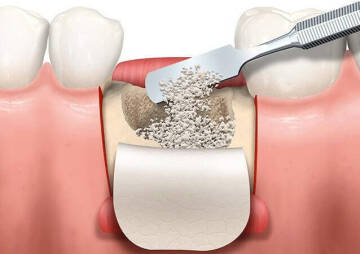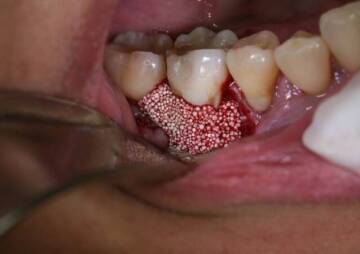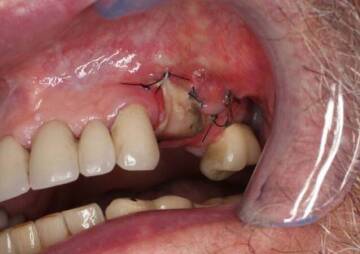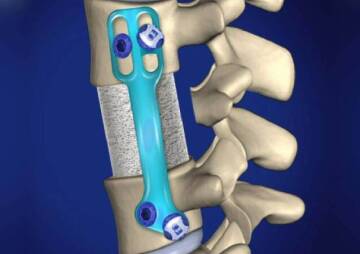-
Category
Craniomaxillofacial Surgery
Orthopedic Surgery
Spine Surgery
Orthopedic Implants
Hip Surgery
Knee Surgery
Pectus Excavatum
Bone Graft
Disinfectants
Healthcare
Dental Bone Graft, What Ever You Should Know

What is a dental bone graft, and is it necessary? What are the benefits and drawbacks of this procedure? Everything you need to know about this strategy is provided in this article.
Dental implants are one of the most widely used methods of restoring missing teeth. To do this, you will visit a dentist, and after an examination, your dentist may advise you that a dental bone graft is required before implant placement. And this often frightens patients, especially when they are unfamiliar with bone grafts for dental implants. But don't worry because the dental bone graft procedure is straightforward and painless. If you're reading this, you're probably a candidate for bone graft surgery and want to learn more about it. You've come to the correct place because this article will explain everything you need to know about dental bone graft, including the technique, the different types of grafts, the cost of surgery, the success rate, the risks, and the side effects.
What Is a Dental Bone Graft?
Part of the jawbone may degenerate over time due to the loss of one or more adult teeth. In this case, you may need a bone graft before the dental implant to increase the amount of bone in the affected area of the jaw. In general, dental bone graft surgery is a painless and simple procedure in which bone taken from any part of the body is fused to the existing bone in the jaw. These bone grafts are taken from the patient's bones, such as the hip, thigh, or back of the jaw. It could also be artificial. You may ask, "are dental bone grafts necessary?"
In response to this question, we must state that this operation is required if the patient does not have enough bone in the jaw to support the implant. Factors such as gum disease, facial injury or trauma, and developmental problems can also damage part of the jawbone, in which case a bone grafting is necessary.
Also visit our bone graft products: Health News Center Bone Graft
How Does a Dental Bone Graft Work?
There are several methods for performing bone graft surgery. However, the general process involves the dentist making a small incision in the jaw and inserting the bone graft into the jaw. Now, how do these bone grafts or powders work? Bone matrix is found in the skeletal system. It is a hard material that helps to strengthen bones. The matrix is formed and maintained by live bone cells within it. Doctors fuse bone grafts containing the matrix and living cells to the jaw. The cells within the new bone can then attach themselves to the old bone. As a result, living bone cells in bone grafts will form a matrix and heal damaged bone. As a result, your jawbone will eventually develop strong enough to support the implant.
Types of Dental Bone Graft
Another concern of patients is the type of dental bone graft. Because the grafts' quality and material, as well as the procedure, are important to them. Dental bone grafts are divided into four types based on their origin and components:
Allografts
Allografts are obtained from the bones of another person, usually a cadaver. Patients typically do not prefer to use these types of grafts, but dentists use them widely today. Allografts themselves come in a variety of forms, such as socket graft and lateral ridge preservation graft. The primary goal of a socket graft is to avoid alveolar bone atrophy. A lateral ridge preservation graft is used to widen the jawbone to accommodate a dental implant.
Autografts
These types of grafts contain bone from your own body, such as the hip or jaw. The block bone graft is a famous example of autograft. Dentists use this type of graft when there are significant defects in the jawbone.
Xenografts
These grafts are made from the bones of other species, such as cows, pigs, or corals. Dentists frequently use these grafts to treat defects in the jaw bone.
Alloplasts
The latest type of dental bone graft is entirely artificial and is made from compounds such as calcium phosphate or calcium phosphosilicate.
The Best Candidate For Dental Bone Graft

Is it possible to have a dental implant without a bone graft? The question is good, and the answer is yes. Dental implants do not always require bone graft surgery. This is possible when you go to a dentist immediately after tooth loss. However, if you wait a few months, the jawbone at the missing tooth site will begin to deteriorate. Under these conditions, you will need a bone graft before a dental implant. Dental bone grafts aren't just for implants. This surgery is required in circumstances such as gum disease, jaw bone accidents and traumas, and developmental abnormalities. As a result, choosing an experienced dentist and using quality bone grafts allows you to have surgery without complications.
Dental Bone Graft Rejection
Another concern of patients is the failure of dental bone grafts. You may ask, is this possible? Although the success rate of dental bone graft is approximately 99.3%, failure may occur. But what causes this failure? Several factors are involved, but the primary cause of bone graft failure is bone graft surgery performed by an inexperienced surgeon. But it can also happen to professional surgeons. A dental bone graft rejection or failure may occur for the following reasons:
- If the bone grafting material is infected with bacteria, the procedure will fail;
- Infection of surgical instruments can cause bacteria to be transferred to the surgical site and the graft to be rejected;
- Failure is possible if the patient does not correctly follow the postoperative care prescribed by the surgeon,
- If you do not maintain good oral hygiene after surgery, you may have problems.
Dental one Graft Rejection Symptoms

Rejection of bone grafts may occur in the early and late stages, each with its own symptoms. Within three to four months after the operation, you may experience early failures. The following symptoms may occur in this circumstance, and you should visit your dentist immediately:
- Dental bone graft swelling: A few days following surgery, swelling in the operative area and part of the face is common. However, if the swelling lasts more than a few weeks or worsens, it's a sign that your body is rejecting the bone graft.
- Acute Pain: A few days following surgery, pain, and swelling are normal because dental bone graft pain is one of the most common side effects of this operation. However, if the pain persists and worsens over time, it may indicate that the bone graft has failed.
- Large Volumes of Leakage: like other surgeries, there is an expectation for some drainage from the treated area. However, if the leak persists and there is a large volume of draining, this is one of the critical symptoms of graft failure, and you should visit a doctor immediately.
- Gum disease: If you have a persistent gum infection for three or four months after surgery, this may indicate a problem with your treatment.
These were signs of early failure of a dental bone graft, but sometimes this failure can occur 6 to 12 months after surgery. Symptoms of late-stage failure vary, and you should pay attention to whether this is related to graft rejection or another disease. These symptoms include the following:
- Bacterial infection in your mouth that affects your gums and other teeth;
- If your oral health worsens despite serious and regular care;
- You've noticed that you're clenching your teeth a lot more than normal;
- If you observe that your gum tissue is receding or that the bone volume around the surgery site is decreasing with time, consult your dentist;
- You could feel pressure on the implant when you eat or chew
- You're suffering from neck or head pain.
As a result, after any surgery, continuous vigilance is advised for many years. If you are aware of these symptoms and go to a doctor on time, you can prevent many oral diseases that can bother you. By contacting a specialist as soon as possible, your surgeon may be able to provide a suitable solution for the problem. However, even a little delay can have irreversible compensating effects.
Dental Bone Graft Risks
Bone graft for dental implants is a simple and usually low-risk surgery. However, patients are always concerned about this surgery's risks and side effects and are willing to learn more about it. In general, surgeries may have some complications, some mild and some very severe. The severity of side effects depends on various factors, such as the surgeon's experience, the use of quality materials, and the patient's physiology. Although dental bone graft surgery is a low-risk procedure, you may experience some of the following side effects that are normal:
- Mild gum bleeding that may last for several days;
- Swelling of the gums and a part of the face that recovers in a few days;
- Difficulty eating, speaking and chewing,
- Pian
These are common side effects that all patients experience three to four days after surgery. However, in rare cases, serious dental bone graft complications may occur and may have dangerous consequences for the patient. Possible complications include:
- Severe bleeding and infection in the surgical area;
- Inflammation, swelling, and excruciating discomfort;
- Nerve damage of the parts of face or gums during surgery;
- An adverse reaction to anesthesia that may occur during or after surgery;
- Your body may reject the transplanted bone;
But remember, these complications are rare and can occur in less than 1% of patients. Furthermore, by carefully selecting your surgeon and taking the necessary precautions following the operation, you can significantly reduce the likelihood of severe side effects.
Dental Bone Graft Surgery Recovery Time

The recovery period for bone graft surgery can range from two weeks to three months, depending on factors such as the type of surgery and the patient's physical strength. However, the bone graft will take three months to heal. Some patients resume their normal activities two weeks after surgery, while others may need 6-12 months to recover. Postoperative care is essential, and if you do it carefully, you will have a shorter recovery period. Here are some dental bone graft healing stages to help you recover quickly:
- You will have mild bleeding in 12 to 24 hours after the operation. To stop it, put a gauze pad in the surgical area and bite a little; keep it in this position for an hour.
- Swelling around the mouth, chin, eyes, and parts of the face is normal. Use an ice pack to reduce the swelling for 48 hours at 30-minute intervals.
- Complete the duration of medications prescribed by your doctor, such as painkillers and antibiotics.
- Avoid strenuous activity for two weeks after surgery as it may cause bleeding.
- Smoking should be avoided for one month prior to surgery and during the healing period because smoking delays the healing process and the development of new bone tissues.
- Eat a soft diet with an average temperature in the first several days following surgery to avoid damaging the surgical area.
How Much Is a Dental Bone Graft?
The cost of dental bone graft surgery varies depending on various factors, including the patient's geographic location, the type of graft applied, and other medical procedures. The average cost is $ 200 to $ 1,300 per graft. This cost is only for artificial bone grafts. So, patients who require an autograft bone will have to pay more because an additional procedure will be conducted in these circumstances. In general, the cost of dental bone grafts is very reasonable, and therefore we advise patients not to delay performing this operation.
The Takeaway
A dental bone graft is a simple procedure used to replace a missing jaw bone. In this method, surgeons use different types of bone grafts according to the patient's needs and the severity of the problem. When is bone graft surgery necessary? If you know how dental implants are done, you will understand the significance of dental bone graft surgery. There must be enough bone in the jaw to hold the implant pins in place for the tooth to be secured appropriately. Therefore, the use of bone grafts is essential for bone growth in the target area. If you are also a candidate for dental bone graft surgery and have questions about a particular subject, write to us so we can guide you.






